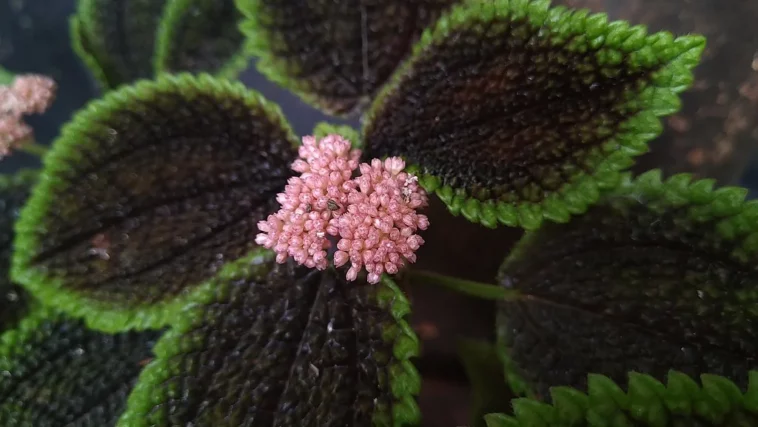Pilea Dark Mystery is a species of plants that easy to care for and has a colourful foliage.
The leaves on this plant are dark green with a tinge of brown and a couple of silvery streaks that run down at either side of the centre vein. The plant flowers in a cluster formation and it develops pink flowers.
Table of Contents
What Does Your Pilea Dark Mystery Require?
Light Requirements
Pilea Dark Mystery plants prefer to be in areas that have bright light. Avoid putting these plants in direct sunlight as this can cause damage such as burnt leaves.
A windowsill is an ideal spot for sitting these plants, but the pot should be rotated twice a week to ensure that all parts of the plant get access to light.
This plant can tolerate a low amount of light. However, this will cause the foliage to turn a darker shade of green and the plant will become leggy.
Temperature Requirements
Pilea Dark Mystery plants are best kept in temperatures around ten degrees centigrade. Avoid subjecting your Pilea Dark Mystery to frost as this can kill the plant.
Keep the plant away from vents and air conditioning as this plant will not do well when subjected to extreme hot or cold air.
Soil Requirements
Pilea Dark Mystery plants prefer to be put in a soil that is moderately rich with a good amount of drainage.
When this plant is in soil that is too soggy, it can cause the roots to rot which can kill the plant.
The best type of potting mix to use for this plant is one that is based on peat moss with some perlite or leaf mould added.
Humidity Requirements
As these plants are native to tropical areas, they enjoy a moderate top high level of humidity. These plants are ideal for growing in terrariums as this will help to maintain a good level of moisture.
How to Water Pilea Dark Mystery
Pilea Dark Mystery plants require a medium to high amount of watering. Water should be added to the plant when the top inch of soil has dried out.
When the leaves start to look droopy, this can be a sign that the plant needs more water. During warmer weather, the plant will need to be watered more compared to colder weather.
How to Fertilise Pilea Dark Mystery
This plant will need to be fed especially during the main growing season. It is best to use a liquid fertiliser that is designed for houseplants, but this should be used at half of the recommended strength.
Pilea Dark Mystery plants will need to be fed twice during the spring and summer months.
Extra Tips for Pilea Dark Mystery
Pests and Diseases
As with all other plants, the Pilea Dark Mystery is prone to some diseases and pests. The pests that tend to affect this plant include spider mites and Mealybugs.
These plants are not to susceptible to diseases, but one disease that can affect them is botrytis and this tends to happen during the autumn and winter months when there is not a lot of natural light.
Pruning
There are no special tips for pruning the Pilea Dark Mystery, but it will need a little pruning to keep it well groomed. It is important to cut back the damaged and dead leaves on the plant.
Thin the plant when it becomes tangled as this will help air to circulate around the plant and will help with the appearance of the plant. Avoid removing more than twenty percent of this plant at one time.
Tackle major pruning projects in smaller stages. When removing dead or damaged leaves, cut at the point where the stem leave connects to the main branch.
Pruning this plant is best completed using sterilised scissors or shears, these can be sterilised using an alcohol solution by rubbing it onto the tool.
It’s important to sterilise the equipment as this will prevent the spread of any pathogens that could cause damage.
Repotting
Repotting is a stressful event for a plant, it can sometimes cause problems for the plant. Reduce the amount of stress on the plant by not being in a rush to repot a new plant, it’s best to wait about a year before re-potting.
Ideally, you want to repot during the spring months as this will give the plant time to re-establish itself. Pilea Dark Mystery does not mind being a little rootbound as the root system is not large. Therefore, bounding is not an issue.
Propagation
Pilea Dark Mystery plants are easy to propagate from stem cuttings, and this is a task that is best completed between early spring and late summer. Tip cuttings are best taken during the spring months.
- Choose a couple of stem tips to take cuttings from.
- Fill a pot with suitable potting mix about three inches deep. The potting mix needs to be moist.
- Put the pots into a sealed bag or a propagation case, as this will help to increase the level of humidity.
- When the plants are kept at about twenty-three degrees centigrade, the roots will grow within three to five weeks.
FAQ
Why is my Pilea turning black?
There are several environmental factors that can affect your Pilea and cause the leaves to turn black. Hot air, especially when it’s a sudden change in temperature. This can remove all the moisture from the plant and cause the leaves to turn black.
Before the plant turns black, in most cases, it will turn brown and shrivel and the continued reduction in moisture will lead to the plant turning black.
How do you take care of a dark mystery plant?
Pilea Dark Mystery plants are very easy to look after and it is easy to encourage the growth of the colourful foliage. The leaves on the plant are dark green with a tinge of brown.
This plant will do best when placed in an eastern facing window.
Why does my Pilea have brown spots?
Brown spots on your Pilea plant can happen as the result of overwatering or over-fertilising. Adding too much fertiliser to the plant can cause chemical burns. Therefore, make sure that you are not adding too much.
Pilea plants do not like to be too moist. Therefore, always let the soil dry out a bit between watering. Brown spots on Pilea plants can also be as result of sunburn. Therefore, ensure that the plant is not getting too much direct sunlight.
Can Pilea grow in low light?
Pilea plants prefer to be in bright but indirect light. However, this plant can survive in environments with low light. When the plant is kept in areas with low light, the foliage will turn a darker shade of green and the plant will become leggy.
Should I mist my Pilea?
Pilea plants are native to areas with high levels of humidity. Therefore, it is a good idea to spray the plant with mist.
Misting is a task that is best done in the morning and the top and bottoms of the leaves should be sprayed, the plant should look like it has a light dew. Pilea Dark Mystery does not need to be sprayed every day and it is fine to do it a couple of times a week.,
Why is my Pilea dying?
When you water your Pilea plant, ensure that the plant is not left sitting in water. After you have watered the plant, tip off the excess water from the bottom dish.
If Your Pilea sits in wet or soggy soil for too long, the roots will become damaged and rot, which can lead to the plant dying.
When can I remove Pilea baby?
Baby cuttings from a Pilea plant can be taken at any time of year. It is best to take the cuttings during the spring months, as this is when the plant has the most energy, and therefore can grow.
The Pilea babies can be removed from the adult plant as soon as they are between two and three inches in size. Avoid chopping away at Pilea babies as soon as you notice them as they need to be big enough to survive on their own.
The longer the baby is attached to the adult plant, the more chance it has for survival.
How to remove a Pilea baby
A Pilea baby can be removed as soon as its between two and three inches in size.
- Push your fingers into the soil around the baby plant and find where the roots go. Follow the roots about an inch into the soil.
- Remove the Pilea baby with the roots still attached. Avoid just pulling or tugging the baby plant out of the soil. It is a good idea to carefully remove a bit of soil around the Pilea baby first as this will expose the root connection and make the removal easier.
- Use a clean and sharp knife to cut the Pilea baby away from the adult plant.
- Once the Pilea baby has been removed, it can be planted directly into soil since it should have roots on it. It is possible to place the new plant into water first to allow more roots to grow.
- The new plant will need to have a lot of bright but indirect sunlight. Do not worry if the plant drops a leave just after potting, as this is only due to the stress of moving the plantlet.
Is Pilea Dark Mystery Toxic?
Pilea plants are not considered to be toxic for dogs, cats, or humans. Therefore, this plant is a great choice for households that have pets or young children.
Abdulhaleems, CC BY-SA 4.0 https://creativecommons.org/licenses/by-sa/4.0, via Wikimedia Commons


